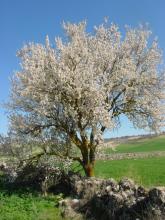Last week the Jewish holiday Tu B'Shvat took place. Tu B'Shvat (a term meaning "the 15th day of the month of Shvat") is a festival centering around agriculture, though in the modern day it is mostly concerned with the care of trees. For this reason it has recently been referred to as Jewish or Israeli Arbor Day. This modern interpretation is rather tangential to the original purpose of Tu B'Shvat, though in many ways it continues in the spirit of the holiday.
Tu B'Shvat is one of four New Year celebrations outlined in the Talmud. Aside from Rosh Hashana, the civil new year, there is an ancient political new year ("the new year of kings and festivals"), a new year for livestock management, and the calendrical/agricultural new year of Tu B'Shvat. In the days of the Temple in Jerusalem, those new year festivals for livestock and agriculture were important in determining the periods of tithing the products of the land. There was a system of resource distribution as described in the Torah and Talmud that fed the priestly caste (who were not permitted to own wealth-producing holdings themselves) as well as the poor who had no resources of their own.
In the simplest terms, Tu B'Shvat was the calendrical mark of the agricultural "before" and "after" points of the harvest season. Fruit-bearing trees were not supposed to be harvested within the first three years of their planting as a measure to encourage responsible, long-term farming. Tu B'Shvat was the official year-mark of the season, so harvesting of trees was permitted after Tu B'Shvat of the fourth year, though the fourth year harvest was always used for the tithes. This controlled the influx of produce to Jerusalem and regulated the way ancient Israelites farmed their land.
After the destruction of the Second Temple by the Roman Empire, Jews had no means of efficiently regulating the land they cultivated because they had no central city for clergy and their population was distributed throughout the world. While Jews could still observe the three-year rule about fruit-bearing trees, the tithing practices ceased to be relevant. Tu B'Shvat has since evolved into an observance related to trees in general, whether as symbols of life and prosperity or as literal things of natural beauty.
Tu B'Shvat took on new meaning in 1890 when Rabbi Zeev Yavetz took his congregation to the relatively new agricultural colony of Zikhron Ya'akov in the Haifa district of Israel. Rabbi Yavetz and his students planted trees there on Tu B'Shvat as a way to give religious significance to the afforestation effort in Israel, a cornerstone of the Zionist movement to make Israel a productive, self-sustaining nation. This custom spread in popularity throughout the 20th century and today Tu B'Shvat is celebrated internationally with the planting of trees. What began as an ancient method of managing agricultural production has transformed into a creative observance of modern environmentalism. This sentiment is in keeping with the Jewish philosophy of tikun olam and is a fine demonstration of the power of community.
